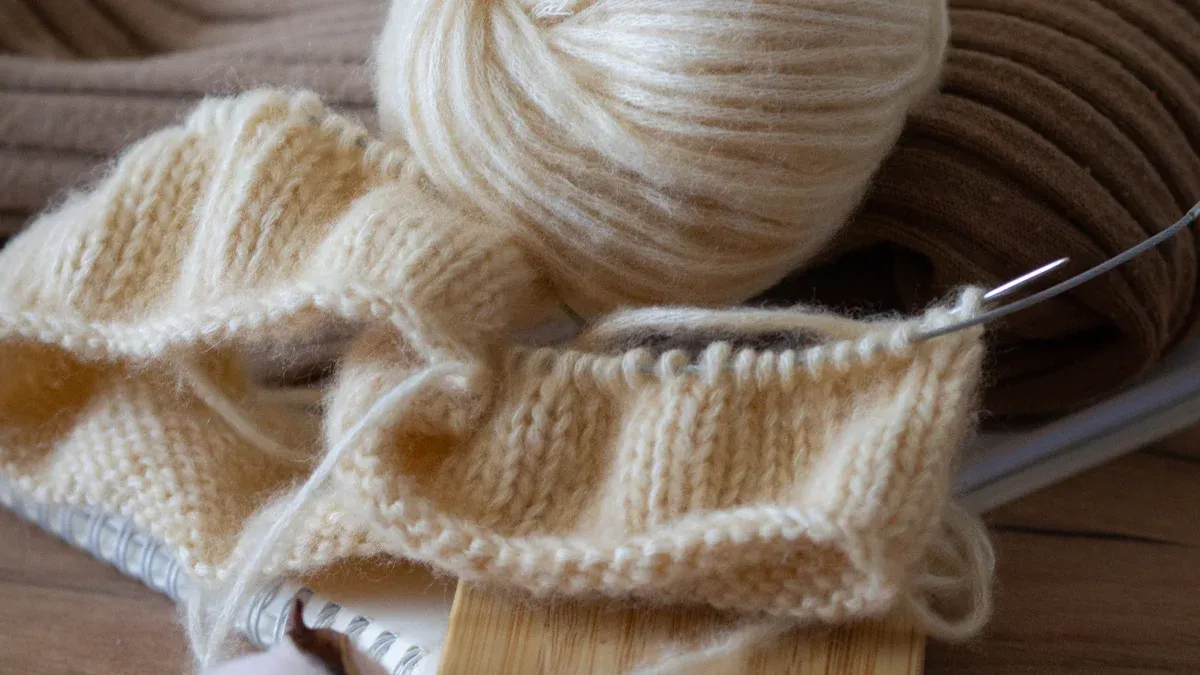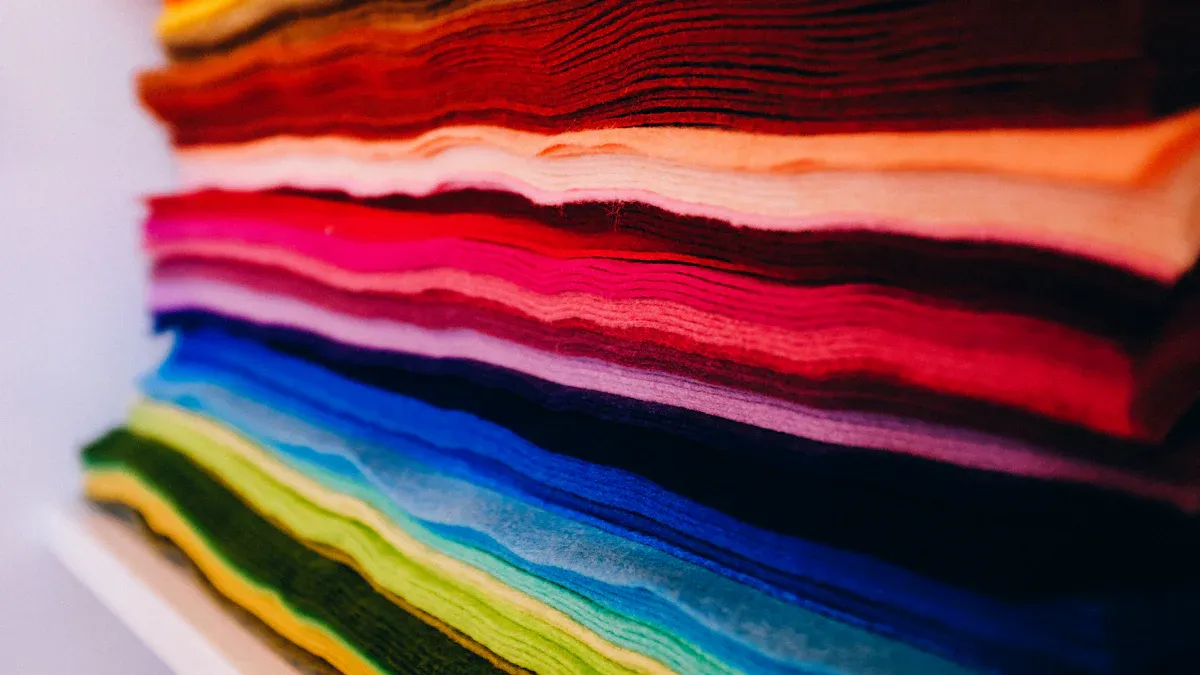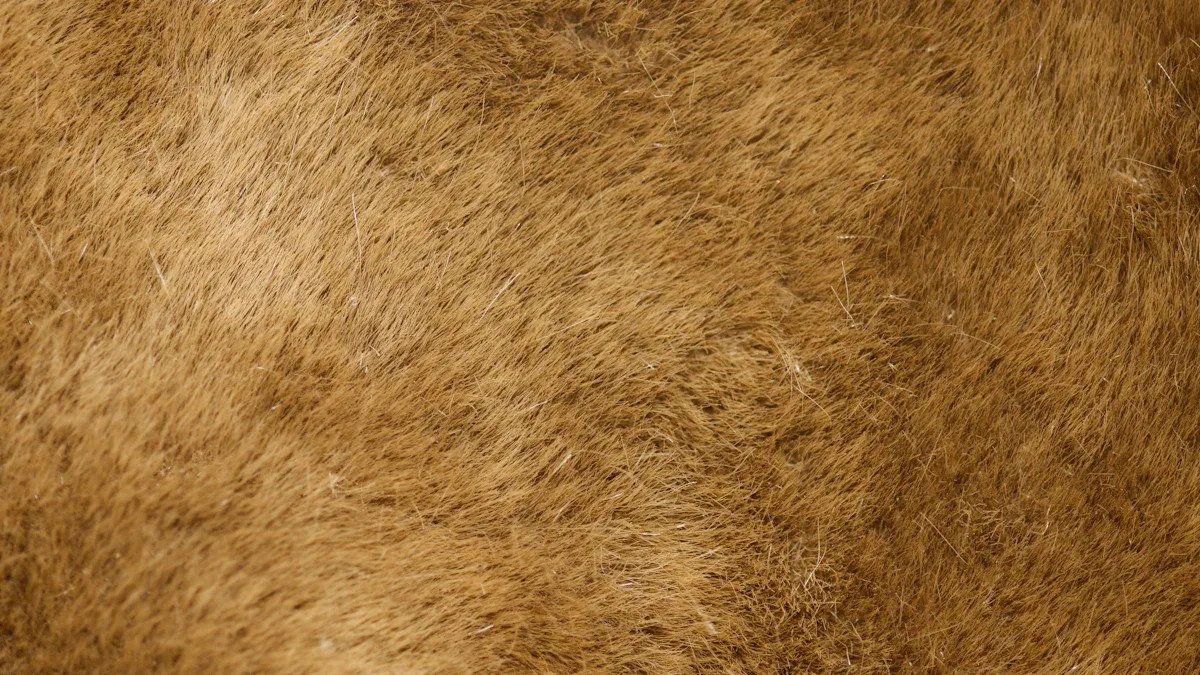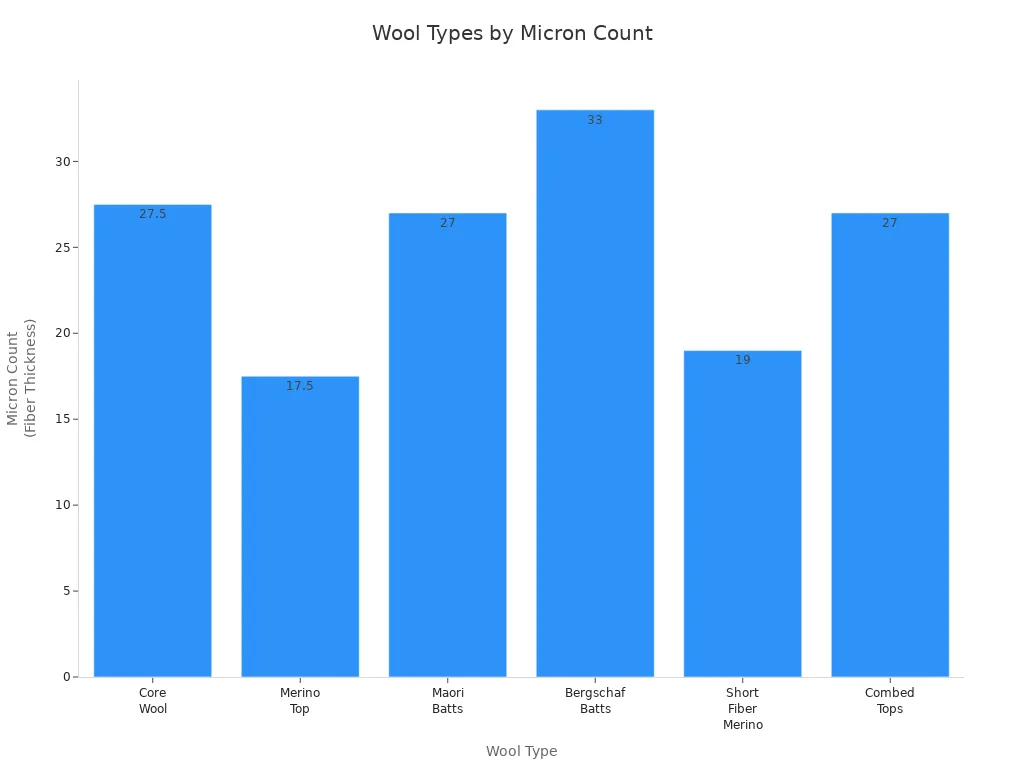
If you want your felting projects to look great and last, choosing 100 wool for felting is a smart move. 100 wool for felting has crimped fibers that help it bind together easily, creating strong and flexible shapes during the felting process. The natural oils in 100 wool for felting also help repel water and dirt. Unlike blends or synthetics, pure 100 wool for felting features tiny scales on each fiber, which lock together with heat and moisture. This unique structure ensures your felting projects are durable and long-lasting.
Key Takeaways
100% wool has small scales on its fibers. These scales lock together fast. This makes felting quicker and stronger. Pure wool felt is tough and lasts a long time. It does not pill easily. It keeps its shape better than blends or fake fibers. Using 100% wool makes your projects look and feel better. The results are smooth, bright, and last a long time. Different wool types work for different felting projects. Beginners should use wool bundles to see what works best. Always store wool the right way. Plan for some shrinking when felting to get the best results.
Felting Basics

What Is Felting
Felting is a process that turns loose fibers into a solid fabric. You can use different methods to create felt, but all of them rely on the way fibers tangle and lock together. Many people use felting wool because it has special scales on each fiber. These scales help the fibers grip each other and form a strong material.
There are several main felting techniques you can try. The table below gives you a quick overview:
Felting Technique | Description | Fiber Choice Impact |
|---|---|---|
Wet Felting | Uses hot water, soap, and agitation to interlock protein fibers, producing a smooth textile finish. | Needs protein fibers with scales, like felting wool. Superwash wool resists felting. |
Nuno Felting | Combines felting wool with open-weave fabric, like silk. | Works best with loose weave fabrics and felting wool. |
Needle Felting | Uses a barbed needle to tangle fibers by hand. | More flexible with fiber types, but felting wool gives the best results. |
Felt Knits | Knits or crochets felting wool, then felts it with water and agitation. | Must use felting wool; man-made fibers do not felt. |
Artfelt | Mixes needle and wet felting with special interfacing. | Needs felting wool, similar to wet felting. |
Felting wool is the top choice for most of these methods. You can see that the structure of felting wool makes it easy for the fibers to lock together. This is why many beginners start with felting wool when learning needle felting or wet felting.
Why Material Matters
The type of fiber you use changes how your project turns out. Felting wool works best because it has tiny scales that catch and hold during the felting process. If you use synthetic fibers, you may find that the fibers do not stick together well. Plant fibers also do not felt easily.
When you use felting wool, you get a fabric that is strong and smooth. Needle felting becomes easier, and your shapes hold together better. For beginners, felting wool helps you learn faster and see better results. Needle felting techniques work best with felting wool because the fibers tangle quickly and stay put.
If you want to make felted pictures, toys, or accessories, always choose felting wool. You will notice that your projects look neater and last longer. Felting wool gives you the best chance for success, whether you use wet felting or needle felting.
100 Wool for Felting

Fiber Structure
When you choose 100 wool for felting, you get fibers with a special surface. Each strand of felting wool has tiny scales that overlap like shingles on a roof. These scales point in one direction and act like hooks. When you agitate the fibers, the scales catch onto each other and lock together. This is what makes pre-felt from 100 wool for felting so effective. Synthetic fibers and wool blends do not have these scales. They cannot interlock in the same way, so they do not felt as easily. Superwash treatments smooth out the scales, which stops the felting process. The natural cuticle structure in 100 wool for felting is the reason your pre-felt holds its shape and stays strong.
Tip: Always look for 100% natural felting wool if you want the best results in your felting projects.
Felting Ability
Felting wool stands out because it felts quickly and evenly. When you use pre-felt made from 100 wool for felting, you notice how fast the fibers mesh together. Scientific studies show that pure wool felts better than blends or synthetics. Acidic water, heat, and agitation make the scales on felting wool lock even tighter. Pre-felt from felting wool responds well to both wet and needle felting. You can shape it into firm, smooth forms that hold up over time. Pre-felt made from other fibers often falls apart or does not stick together. This is why felting wool is the top choice for all felting projects.
Wool fibers also absorb water well. They can take in up to one-third of their weight in moisture. This helps the fibers move and lock during felting. After felting, pre-felt made from 100 wool for felting keeps its shape. The strong bonds inside the wool make your finished wool felt sturdy and stable. You can use felting wool for wet felting, needle felting, or even nuno felting. Each method works best with pre-felt from 100 wool for felting.
Durability
You want your felting projects to last. Pre-felt made from 100 wool for felting gives you that long-lasting quality. Wool felt made from pure felting wool is more resilient than blends or synthetics. The natural elasticity of felting wool lets your pre-felt bounce back from stretching or bending. High-quality wool felt can last for many years if you care for it. Garments made from pure felting wool may last five to ten years or more. Decorative items can last even longer. Blends and synthetics may cost less, but they do not match the durability of pure wool felt.
Material Type | Additional Notes | |
|---|---|---|
100% Wool Felt | Unlikely to pill | Dense, smooth, hard-wearing, cuts cleanly |
Wool Blend Felt | Somewhat likely to pill | Thinner, less dense, tends to bobble and stretch |
Synthetic Felt | Very likely to pill | Thin or stiff, plasticy shine, stretches easily |
Pre-felt made from 100 wool for felting resists pilling. This means your wool felt stays smooth and neat, even after lots of use. You can cut pre-felt cleanly, and it will not fray or stretch out of shape. This makes felting wool the best choice for projects that need to look good and last.
Appearance
Wool felt made from 100 wool for felting has a look and feel you cannot get from blends or synthetics. The fibers interlock tightly, giving the surface a smooth, dense finish. Pre-felt from felting wool takes dye beautifully, so your colors stay bright and even. You can use pre-felt for hats, flowers, animals, quilts, and more. The fabric feels firm and holds its shape well. It does not stretch or sag, so your felting projects keep their form.
Wool felt has a woollier, richer appearance than other felts.
The fabric feels substantial and has a nice weight.
Pre-felt from felting wool is perfect for children’s toys, clothing, and home décor.
The smooth, dense surface lets you create sharp details and clean edges.
Wool felt dyes evenly, so your finished projects look vibrant and professional.
Pre-felt made from 100 wool for felting is firm, not stretchy, and keeps its shape over time.
When you use pre-felt from 100 wool for felting, your felting projects stand out. The finished wool felt looks natural and high-quality. You get a fabric that is both beautiful and practical.
Comparing Felting Wool Types
100 Wool vs Blends
When you look at 100% wool and wool blends, you see big differences. Pure felting wool makes pre-felt that is thick and smooth. It keeps its shape and does not pill much. Wool blends have only some wool, mixed with synthetic fibers. This makes the pre-felt thin and not as strong. Blends can stretch and pill more. This can mess up your needle felting designs and finished work.
Here’s a quick comparison:
Feature | 100% Wool Felt | Wool Blend Felt |
|---|---|---|
Density & Thickness | Dense, smooth, matte | Thinner, sometimes shiny |
Durability | Hard wearing, resists pilling | Prone to pilling, stretches out |
Water Repellency | Naturally water repellant | Not water repellant |
Suitability | Heirloom items, toys | Large crafts, less wear |
Cost | More expensive | Less expensive |
You pay more for pure felting wool, but it lasts longer and looks nicer. Wool blends are good for fast crafts. If you want the best fabric for needle felted pictures, use pure felting wool.
100 Wool vs Synthetics
Felting wool made from 100% wool works better than synthetic fibers. Wool fibers have special scales and crimp. These help the pre-felt stick together tightly. Synthetic fibers do not have these features, so they do not felt well. Your projects might fall apart or look fuzzy with synthetics. Wool felt is soft and strong. It does not fray. Synthetic felt can tear and stretch.
Note: 100% wool breaks down in nature. It is better for the earth than synthetic felting fibers, which can cause microplastic pollution.
Synthetic felts cost less, but they do not work as well. If you want your needle felting to last, always choose pure felting wool.
Best Fabric for Needle Felted Pictures
To make great needle felted pictures, you need a strong base. The best fabric for needle felted pictures is 100% wool felt. This pre-felt does not fray or bend, even with many layers. You can cut, sew, or glue it for your needle felting designs. Wool felt holds thick wool shapes without changing shape. This makes it perfect for landscapes, portraits, and other needle felted pictures.
Wool felt is easy to needle felt and keeps your designs sharp.
Pre-felt from 100% wool helps you make detailed needle felted pictures.
The best fabric for needle felted pictures lets you add many layers and fine details.
When you use the best felting wool and pre-felt, your needle felted pictures will look great and last a long time.
Choosing Felting Wool
Types of Wool
You have many choices when it comes to felting wool. Each type has its own feel and best use. Merino wool is soft and fine. It works well for detailed needle felted pictures and smooth surfaces. Corriedale wool is a bit coarser and gives a firm base. Romney and Shetland wools are good for wet felting. They create strong, durable felt. Finn wool and Blue-faced Leicester add texture and shine to your projects. Some felting wool comes from cross-breeds, which can offer a mix of softness and strength.
Here is a table to help you compare common types of felting wool:
Wool Type | Common Use | Fiber Characteristics | Felting Properties | Typical Projects |
|---|---|---|---|---|
Merino Wool | Needle Felting | Fine, soft fibers, consistent diameter | Felts evenly, smooth finish, soft texture | Detailed sculptures, toys, ornaments |
Corriedale Wool | Needle Felting | Medium-coarse, slightly coarser | Felts quickly, firm and strong base | Durable animals, figures, ornaments |
Romney Wool | Wet Felting | Medium-coarse, high crimp and density | Felts rapidly and evenly, resilient | Felted bags, hats, accessories |
Shetland Wool | Wet Felting | Coarser, natural crimp and elasticity | Felts quickly, firm and durable | Rugs, mats, outerwear |
Finn Wool | Artistic Felting | Long staple, soft yet strong fibers | Felts quickly, fluffy finish | Mixed textures, sculptural forms |
Blue-faced Leicester | Artistic Felting | Long fibers, lustrous and soft | Silky texture, good for draped pieces | Wearable art, shawls, ornaments |
You can also find felting wool bundles that include several types. These bundles help beginners try different fibers and see what works best for their needle felting patterns.
Quality Tips
When you pick felting wool, look for high quality. Color matters, especially if you want bright needle felted pictures. Staple length affects how the wool felts. Short fibers felt fast and make smooth surfaces. Long fibers are good for 3D effects and fur. The micron count tells you how thick the fibers are. Lower micron counts mean softer wool, which is great for delicate work. Higher micron counts give you stronger felt for sturdy items.
Here is a chart showing how micron count affects felting wool:

You should also check for malleability. Good felting wool holds its shape and felts quickly. For core shapes, use wool that is easy to mold. For surface details, choose finer wool. Always check for vegetable matter in cheaper felting wool, as it can affect the finish. Many felting wool bundles list the micron count and staple length, which helps you pick the right wool for your project.
Tip: Beginners should start with a felting wool bundle that includes both core wool and finer surface wool. This makes it easier to follow needle felting patterns and get good results.
Project Suitability
Different felting wool types work better for certain projects. For soft toys, hats, or clothing, use fine Merino or Finn wool. These feel nice against the skin. For sturdy items like rugs or bags, pick Shetland or Romney wool. These types make strong, thick felt. If you want to create needle felted pictures, use a firm, smooth wool felt base. This helps your designs stay sharp and neat.
Wool Content | Density (g/cm³) | Typical Uses | Suitability for Felting Projects | |
|---|---|---|---|---|
F-1 | Min. 95% | High (0.32-0.36) | Impact, abrasion-heavy uses, oil absorption | Best for heavy-duty, not soft crafts |
F-5 | Min. 95% | Medium-High (0.25-0.27) | Cushioning, floor mats, seat pads | Good for crafts needing some softness |
F-7 | Min. 80% | Medium-High (0.25-0.27) | Vibration mountings, wipers | Suitable for moderate impact crafts |
You can use different felting wool for the inside and outside of your project. Core wool is cheaper and works well for the base. Use softer wool on the outside for a smooth finish. This method saves money and gives you a high-quality look. Beginners often find this approach helpful. Always match your felting wool to your project’s needs for the best results.
Final tips for beginners: Try a felting wool bundle to explore different textures and colors. Choose high quality wool and the right type for your project. With the right needle felting supplies, you will enjoy making beautiful, lasting creations. Remember, final tips for beginners always include starting simple and learning as you go.
Picking 100% wool for felting gives you lots of benefits. You get to work with your hands and make things that last a long time. Wool’s natural fibers help you try new ideas, like making 3D art or clothes. The finish feels soft and comfy, and it looks better than blends or fake fibers.
Wool felting is great for both beginners and experts.
Felting with wool helps you feel calm and focused.
You can count on your finished project to be high quality.
Use 100% wool for your next felting project. You will see the difference in every part.
FAQ
What makes 100% wool better than wool blends for felting?
You get stronger, smoother felt with 100% wool. The natural scales on each fiber help the wool lock together. Blends often include synthetic fibers that do not felt well. Your projects last longer and look more professional with pure wool.
Can you use 100% wool for both wet and needle felting?
Yes, you can use 100% wool for both methods. The fibers tangle and hold together easily. You get firm shapes with needle felting and smooth surfaces with wet felting. Pure wool works best for most felting techniques.
How do you store 100% wool for felting projects?
Store your wool in a cool, dry place. Use sealed bags or boxes to keep out dust and moths. Avoid direct sunlight. You protect the fibers and keep your wool clean and ready for your next project.
Does 100% wool felt shrink during the felting process?
You will notice some shrinkage when you felt 100% wool. The fibers tighten and lock together. Plan for this by making your project a bit larger than the finished size you want.
Is 100% wool felt safe for children’s crafts?
You can use 100% wool felt for children’s crafts. It is natural and non-toxic. Always supervise young children, especially when using felting needles. Wool felt is soft and safe for toys, decorations, and art projects.









